
Discover more Outdoor Sports books, eBooks, and expert advice to plan your next adventure! From bow hunting to paddling to hiking the Appalachian Trail, Stackpole's Outdoor Sports books give you the tools you need to experience the great outdoors to its fullest. Visit Stackpole Books Outdoor Sports webpage

C HAPTER O NE

H OME -D RIED O NE -P OT M EALS

The ancient art of food dehydration is wonderfully basic. Heat and air circulation remove most of the water content from the food. This lack of water keeps microorganisms from living and growing. After many years of home-drying complete backpack meals, I have never lost food to spoilage. Follow the simple instructions in this chapter and the recipes in chapters through five of this book and you will enjoy the same success.
Dehydration is especially suited to backpacking. Not only does drying forestall spoilage, it also transforms bulky, heavy food into compact, featherweight meals. Dehydration costs less than any other method of food preservation. It requires no chemicals. Complete meals can be dried year round in any weather, at your convenience. Take advantage of each seasons bounty, using the finest fresh ingredients available, or use good-quality canned or frozen meat, fish, fruit, or vegetables.
Home-dried meals can be stored for several years. Its easy to keep a ready supply of home-dried dinners on hand for carefully planned extended treks, as well as last-minute weekend escapes.  Creating home-dried one-pot meals is this simple. Creating home-dried one-pot meals is this simple: Cook your dinner at home, slicing, grating, or dicing the ingredients into small pieces. Spread the cooked meal on covered dehydrator trays and dry until the food looks and feels completely dry.
Creating home-dried one-pot meals is this simple. Creating home-dried one-pot meals is this simple: Cook your dinner at home, slicing, grating, or dicing the ingredients into small pieces. Spread the cooked meal on covered dehydrator trays and dry until the food looks and feels completely dry.
Food Choices

You dont have to settle for someone elses idea of a good hot dinner.
Food Choices

You dont have to settle for someone elses idea of a good hot dinner.
When you make your own convenience meals, you are in control: more salt or less salt, high fat or low fat, meat or meatlessthe decision is yours. You can use your choice of dairy, soy, or rice milk or cheese in any of these recipes. Like it hot? Add more jalapeos. Cant eat sugar? Use a substitute. Liberate yourself from one-size-fits-all commercial meals. You enjoy good meals at home; while backpacking, you need those same good-tasting, varied, nutritionally balanced meals more than ever.
Some backpackers shortchange themselves. They eat the same tired instant mashed potatoes or ramen noodles day after day. Varied, nutritionally balanced meals not only give you energy on the trail, but also keep your mind focused and make you feel happy and satisfied.
In the Home

Food Dehydrator A high-quality electric food dehydrator with fan, heat source, and thermostat is the best food investment a backpacker can make. If you do not own a dehydrator, borrow one from a friend or relative. Try some of the recipes in this book.
You will learn how simple it is to create your own one-pot meals. The dehydrator, not you, does the work. A top-of-the-line dehydrator will pay for itself, compared to the price of commercially dried meals, during a one-week trip for a family of four. Air circulation is more important than heat when you are drying food, so be sure to choose a dehydrator with a fan as well as a heat source and a thermostat. Bargain dehydrators that lack a fan simply dont work. They will steamnot dryyour food.
Either of the following brands of electric food dehydrators are recommended for decades of carefree home drying: Excalibur Products (www.excaliburdehydrator.com, 800-875-4254) or NESCO American Harvest (www.nesco.com, 800-288-4545). Home Kitchen Basics All of the one-pot dehydrated meals in this book serve four hungry backpackerstwo cups or more per serving when rehydrated. The four large portions indicated in these recipes will fit comfortably in typical home food dehydrators without crowding. To cook these big, full-sized backpacking portions of food, you will need to use large cooking pots at home. Here are some suggested home kitchen basics: Dutch oven, at least three-quart capacity Large ovenproof skillet, at least 10-inch diameter Soup and pasta pot, at least five-quart capacity Colander to drain pasta, fruits, and vegetables Casserole dish, at least four-quart capacity, ten by thirteen inches Baking sheets, both flat and rimmed Blender or food processor to speed chopping Electric hand blender for fast pures Drying One-Pot Meals in a Dehydrator Time-saving tip: Prepare extra food, enjoy some for dinner tonight, and dehydrate the rest. Choose a one-pot complete meal recipe from this book.
Cook your meal at home, just as though you are preparing tonights dinner. If you choose a meal such as spaghetti, simply prepare a spaghetti sauceyour choice of beef, seafood, or vegetarian. Then boil the pasta al dente (cooked but still firm). Toss together the sauce and the drained pasta, and put the whole dish, freshly cooked and still warm, into the dehydrator. While preparing the food, chop, grate, dice, or slice the ingredients into small pieces. These will dehydrate much faster and more successfully than large pieces of food.
Virtually all cooked foods are safe and easy to dry at home. Two uncooked foods that should never be dried at home are eggs and milk. When cooked, these foods dehydrate safely. Many of the recipes in this book contain cooked eggs and milk. To avoid the risk of salmonella contamination, buy commercially dried powdered eggs. They are readily available everywhere as whole eggs, egg whites, or egg substitutes for home cooking, baking, or emergencies.
Dry milk is also readily available commercially as instant or regular, high or low fat, or buttermilk.  Cover mesh dehydrator trays. While the food is cooking, cover your mesh dehydrator trays with plastic wrap or ovenproof parchment paper. If you use plastic wrap, buy a brand made from 100 percent polyethylene. Leave about an inch of space between the wrap or paper and the edge of the trays; this will allow more air circulation. To keep the covering from shifting, you can anchor the corners with tape.
Cover mesh dehydrator trays. While the food is cooking, cover your mesh dehydrator trays with plastic wrap or ovenproof parchment paper. If you use plastic wrap, buy a brand made from 100 percent polyethylene. Leave about an inch of space between the wrap or paper and the edge of the trays; this will allow more air circulation. To keep the covering from shifting, you can anchor the corners with tape.
If your dehydrator has solid fruit leather trays or tray covers, you do not need to use any other covering. The wrap, paper, solid trays, or tray covers simply keep liquid foods such as soups, stews, or casseroles from leaking through the mesh of the dehydrator trays. Preheat the dehydrator for ten minutes. Spread the warm, cooked meal evenly in a thin layer on the dehydrator trays and put them in the dehydrator. Overloaded trays dry slowly. All of the one-pot recipes in this bookwhich make four servings eachfit comfortably into a typical home dehydrator.
Next page
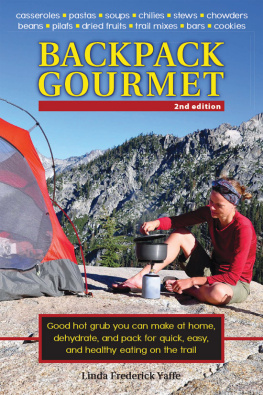
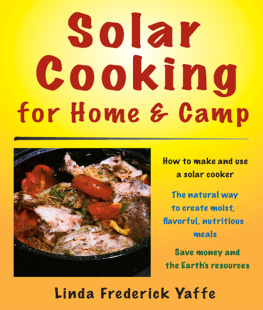
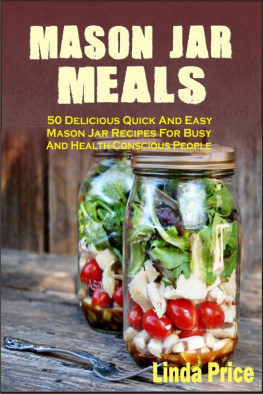


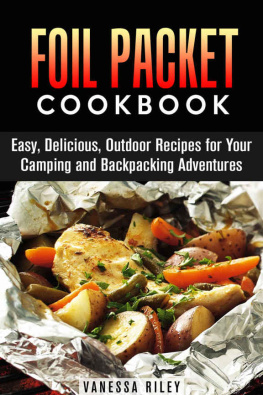
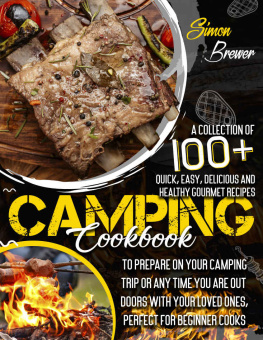

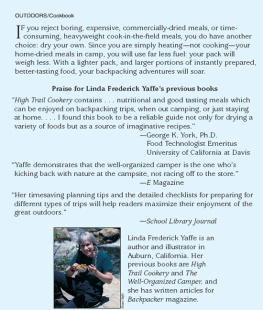
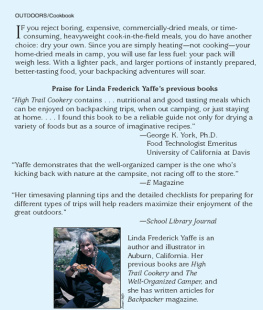

 C HAPTER O NE
C HAPTER O NE  The ancient art of food dehydration is wonderfully basic. Heat and air circulation remove most of the water content from the food. This lack of water keeps microorganisms from living and growing. After many years of home-drying complete backpack meals, I have never lost food to spoilage. Follow the simple instructions in this chapter and the recipes in chapters through five of this book and you will enjoy the same success.
The ancient art of food dehydration is wonderfully basic. Heat and air circulation remove most of the water content from the food. This lack of water keeps microorganisms from living and growing. After many years of home-drying complete backpack meals, I have never lost food to spoilage. Follow the simple instructions in this chapter and the recipes in chapters through five of this book and you will enjoy the same success.  Creating home-dried one-pot meals is this simple. Creating home-dried one-pot meals is this simple: Cook your dinner at home, slicing, grating, or dicing the ingredients into small pieces. Spread the cooked meal on covered dehydrator trays and dry until the food looks and feels completely dry.
Creating home-dried one-pot meals is this simple. Creating home-dried one-pot meals is this simple: Cook your dinner at home, slicing, grating, or dicing the ingredients into small pieces. Spread the cooked meal on covered dehydrator trays and dry until the food looks and feels completely dry. Cover mesh dehydrator trays. While the food is cooking, cover your mesh dehydrator trays with plastic wrap or ovenproof parchment paper. If you use plastic wrap, buy a brand made from 100 percent polyethylene. Leave about an inch of space between the wrap or paper and the edge of the trays; this will allow more air circulation. To keep the covering from shifting, you can anchor the corners with tape.
Cover mesh dehydrator trays. While the food is cooking, cover your mesh dehydrator trays with plastic wrap or ovenproof parchment paper. If you use plastic wrap, buy a brand made from 100 percent polyethylene. Leave about an inch of space between the wrap or paper and the edge of the trays; this will allow more air circulation. To keep the covering from shifting, you can anchor the corners with tape.